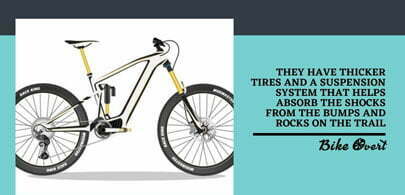Hardtails are great for commuting and exploring dirt roads, but they can’t handle big hills or jumps. If you’re looking to take your mountain biking to the next level, converting your hardtail to full suspension is the way to go. There are a few things you’ll need to do first, though: find a good suspension setup, buy the parts, and install them. Once everything is installed, you’re ready to ride! To get the answer can you convert a hardtail to full suspension read the complete article.
What is a hardtail bike?

A hardtail bike is a mountain bike that has a suspension fork in the front, but no rear suspension. This makes the bike more lightweight and simpler than a full-suspension mountain bike, and also cheaper.
Hardtail bikes are ideal for cross-country biking and less technical trails, as they provide more efficiency and better pedaling performance than a full-suspension bike. However, they can also be used for more aggressive riding on rougher terrain, depending on the model.
What is full suspension mountain bike?

A mountain bike is designed to be ridden on rough, uneven terrain. They have thicker tires and a suspension system that helps absorb the shocks from the bumps and rocks on the trail. There are different types of suspension systems, but the most common one is full suspension. This means that both the front and rear wheels have a suspension system.
A full suspension mountain bike is more expensive than a hardtail mountain bike, but it provides a smoother ride. It is also more difficult to pedal up hills because of the extra weight, but it is easier to go downhill. Some people find that a full-suspension mountain bike is too bouncy and unstable for them, so they prefer a hardtail mountain bike.
What are the benefits of a hardtail bike?
There are many benefits of owning a hardtail mountain bike. Some of these benefits include increased efficiency, better handling, and more traction.
- A hardtail bike is a great option for someone looking for a versatile and affordable bicycle.
- They are also great for fitness and commuting because they are lightweight and easy to maneuver.
- Hardtail bikes are perfect for beginner cyclists because they are easy to ride and maintain.
- Hardtail bikes are less expensive than full-suspension bikes, making them a great option for budget-conscious cyclists.
What are the disadvantages of a hardtail bike?
- If a hardtail bike is a type of mountain bike that has a frame with no rear suspension. This can be a disadvantage because it can be more difficult to ride over rough terrain.
- Another disadvantage of a hardtail bike is that it can be more difficult to control when going down steep hills. This is because the bike lacks the cushioning that a rear suspension provides.
- Additionally, a hardtail bike can be less comfortable to ride than a full-suspension mountain bike. This is because there is no shock absorption in the frame, which can cause more vibration and discomfort when riding on bumpy trails.
What are the benefits of full suspension mountain bikes?
When most people think of mountain biking, they think of a bike with a hardtail – a frame with a solid front suspension fork. While these bikes are good for riding on smoother surfaces, they can’t compare to the benefits of a full-suspension mountain bike when it comes to riding on rougher terrain.
- Full suspension mountain bikes have shocks in both the front and rear of the frame which help to absorb the bumps and shocks from the trail, making for a much more comfortable ride. This not only makes the ride more enjoyable, but it also helps to reduce fatigue, meaning you can ride longer and harder.
- Comfort is a huge benefit of full suspension mountain bikes. The shock absorbers help to soak up the bumps and vibrations from the trail, which makes for a smoother ride. This is especially beneficial on rocky or bumpy trails.
- Another key benefit of full suspension mountain bikes is that they offer greater control. With the shocks absorbing the bumps, you have more precision when steering and maneuvering around corners. This can be especially important when riding at high speeds or in tricky terrain.
- Improved traction is another key benefit of full suspension mountain bikes.
What are the disadvantages of full suspension mountain bikes?
Mountain biking is a popular sport because it offers an adrenaline rush like no other. For some, the appeal of mountain biking is the challenge of riding on rough terrain. For others, it’s the thrill of flying down a hill as fast as possible. No matter what your reason for mountain biking, if you’re looking to buy your first bike or are thinking of upgrading, you may be wondering if you should get a full suspension mountain bike.
- Probably the biggest disadvantage of a full suspension mountain bike is the extra weight. They are typically quite a bit heavier than their hardtail counterparts.
- Additionally, they can be more difficult to pedal uphill and require more maintenance due to all the moving parts.
- Another downside is that they can be more expensive than hardtails. So if you’re on a tight budget, you may want to consider opting for the latter instead.
Purchaseing a new full suspension bike will be a good decision
If you are on a budget, you may be considering converting your hardtail bike to a full suspension bike. However, this is not always the best option. A full suspension bike within your budget will provide you with a better riding experience than converting your hardtail bike.
One reason to buy a full suspension bike is that it will be more comfortable to ride. A hardtail bike can cause pain in the back and neck after long rides because of the jarring caused by the uneven terrain. A full suspension bike will absorb some of this shock, which will make for a more comfortable ride.
Another reason to buy a full suspension bike is that it will be more efficient on rough terrain.
What are the reasons to convert a hardtail to full suspension?
There are many reasons why people might choose to convert a hardtail mountain bike into a full suspension model. Some riders might find that they are experiencing too much jarring and vibration on their hardtail, particularly on rough terrain.
Others may simply find that a full suspension mountain bike offers more control and stability when riding, which can translate into a more enjoyable experience.
Additionally, those who are looking to upgrade their mountain biking skills may find that a full suspension bike allows them to do so more effectively, as it provides an extra level of stability and control.
Ultimately, the decision to convert to full suspension comes down to personal preference and what the rider hopes to get out of mountain biking.
What are the hardtail to full suspension conversion kits?
There are a few different hardtail to full suspension conversion kits on the market. They can be a great way to upgrade an old hardtail bike into a new, full suspension bike. The kits typically include a new frame, new suspension forks, and sometimes a new rear shock. The installation process can be a little bit complicated, so it is best to consult with a bike mechanic before attempting to install one of these kits yourself.
The main benefit of using a hardtail to full suspension conversion kit is that it can be significantly cheaper than buying a brand new full suspension bike. Additionally, using an older hardtail frame as the basis for a new full suspension bike can often result in a lighter overall weight for the finished product. There are some drawbacks to using these kits, however. First and foremost, the installation process can be difficult and time consuming.
Do I really need full suspension on my bike?
For mountain biking, there are two main types of suspension: front suspension, which is found on most bikes and provides cushioning for the rider’s hands and arms; and full suspension, which includes both front and rear suspension systems. While front suspension is considered adequate for most riding conditions, some riders feel that full suspension is necessary for more extreme riding.
Whether you need full suspension on your mountain bike depends on how you plan to use it. If you’re just starting out or you’re not into extreme riding, then front suspension will probably be just fine. Full suspension can be more expensive and add weight to the bike, so it’s not necessary for everyone. If you’re interested in doing some more challenging trails or downhill riding, then full suspension may be a better option for you.
Ultimately, the decision comes down to personal preference and what you’re willing to spend. If you are interested to know more whethere you need a full suspension or not then read this article. The article is dedicated to this matter.
What are the methods to convert a hardtail to full suspension?
There are a few different methods of converting a hardtail mountain bike to full suspension. One option is to add a rear shock to the hardtail frame. Another option is to use a full suspension frame as the basis for the conversion and add a hardtail fork. A third option is to purchase a complete full suspension mountain bike and convert the rear triangle to fit onto the hardtail frame.
Each of these methods has its own advantages and disadvantages. Adding a rear shock to a hardtail frame is the simplest method, and it is also the cheapest. However, this method can be less effective than other methods, because it can be difficult to achieve an optimal level of compression and rebound damping with just a single shock absorber.
How to add a rear shock to the hardtail frame?
Adding a rear shock to a hardtail frame is a great way to convert a hardtail into a full suspension bike. The process is not too difficult, but it is important to take your time and measure everything correctly. Here is a step-by-step guide on how to do it:
- The first step is to remove the seatpost and saddle from the frame. This will give you more space to work with.
- Next, remove the brake calipers and associated hardware from the frame
- Disconnect the derailleur from the frame and remove it completely.
- Remove the screws that hold the chainstay in place and pull it out of the frame.
- Now you can install the rear shock. Begin by threading one end of the shock through the hole in the chainstay.
use a full suspension frame as the basis and add a hardtail fork
If you want to convert your hardtail frame to a full suspension frame, you can add a hardtail fork. This will add rear suspension to your bike and make it into a full-suspension frame.
- To add a hardtail fork to your bike, first remove the screws that hold the current fork in place.
- Then, remove the old fork and replace it with the new one. Make sure that the screws are tight so that the fork does not move around while you are riding.
- Next, tighten the bolts on the top of the fork that hold the wheel in place.
A video for converting a hardtail to full suspension
When should I switch from hardtail to full suspension?
There is no definitive answer to this question as everyone’s riding style and preferences are different. However, there are a few factors to consider when making the switch from hardtail to full suspension.
One key consideration is how much you ride and where you ride. If you’re only doing occasional weekend rides, a hardtail might be just fine. But if you’re hitting the trails every day or multiple times a week, you’ll likely appreciate the added comfort and stability of a full suspension bike.
Another thing to consider is your level of experience. If you’re just starting out, it might be worth sticking with a hardtail until you get more comfortable on the bike and develop your skills. Once you have a good handle on things, switching to a full suspension will make your rides even more enjoyable.
Conclusion
In conclusion, it is possible to convert a hardtail mountain bike into a full suspension mountain bike. The process is not difficult, but it does require some time and effort. By following the steps outlined in this article, you can create a custom mountain bike that is perfect for your needs.




